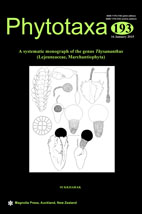Abstract
A world-wide revision of the liverwort genus Thysananthus (Marchantiophyta: Lejeuneaceae) leads to the recognition of fifteen species in two sections: sect. Thysananthus (eleven species) and sect. Vittatae (four species). The genus is monophyletic with the inclusion of Dendrolejeunea fruticosa and Mastigolejeunea pancheri, and lacks synapomorpies. Morphological characters of Thysananthus are non-exclusive, and include Lejeunea-type branching, epidermal cells mostly as large as medullary cells, leaves convolute when dry, leaf cells elongate, trigones cordate, oil bodies segmented, underleaves often adnate to leaves, innovations lejeuneoid, and female involucres (incl. perianths) usually toothed. The two sections are characterized by the absence versus presence of a vitta. Species are defined by the possession of two or more independent, diagnostic morphological characters and monophyly. Based on phytochemical and molecular evidence T. gottschei, previously considered a synonym of T. convolutus, is resurrected as a distinct species. One variety, T. gottschei var. continuus, is newly described, and the new combinations T. convolutus var. laceratus and T. retusus subsp. sellingii are proposed. A key to the species of the genus Thysananthus is provided and each species is fully described and illustrated, with complete synonymy and detailed data on habitat and distribution. Thysananthus is pantropical in distribution, with four species ranging into warm temperate regions; the centre of diversity of the genus is in Southeast Asia. The species grow as epiphytes in moist lowland and montane forests, and include ecological specialists (shade epiphytes, sun epiphytes) as well as generalists.

